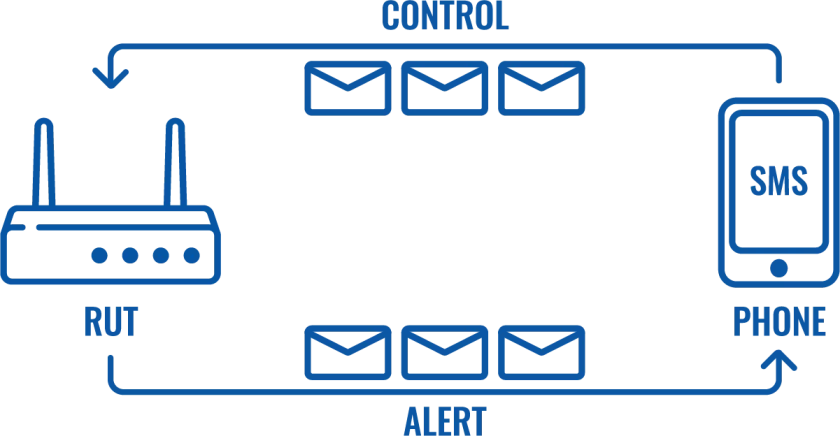KEY ADVANTAGES OF RUTOS: RELIABILITY
#rutos, #iot
In this series of articles, we would like to take a closer look at the software at the heart of Teltonika Networks products – RutOS. RutOS is a unified operating system based on OpenWrt. It is factory-embedded into every Teltonika Networks device, so no installation is required from the user, and there are no additional costs. This system enables our customers to have an excellent user experience due to its’ incredibly intuitive interface.

RutOS helps to significantly cut costs on engineers’ training while implementing new products. Besides, it grants flexibility when migrating between different devices and platforms. The system is open-source; therefore, every client can change and adapt RutOS to get the most out of each Teltonika Networks device. Let’s look more deeply at how our software can help you achieve your business goals as we are focusing on its’ three core qualities: reliability, security, and ease of use.
RELIABILITY
Connection stability and overall reliability is definitely at the top of the priority list when choosing an industrial router. Throughout the development process of RutOS, we included a variety of safeguards to ensure that the devices are accessible and functioning properly at all times while affording a possibility to manage them remotely. We would like to take this opportunity to introduce you to the most important features, helping Teltonika Networks products stand out in the market.
AUTO-REBOOT
One of such properties is Auto-Reboot. Automatic reboots can be used as a routine or precautionary measure to ensure that the device will self-correct some unexpected issues, especially related to connection downtime. This feature alone can prevent major service disruptions to ensure critical business continuity and solve any reliability issues before they make an impact on your solution!
Ping Reboot function periodically sends requests to a specified IP address or host and waits for a response. If no response is received, the device will attempt the same action a defined number of times at a defined frequency. If there is still no response, the device will execute a specified action, which can be pre-set according to your specific needs. For example, it could trigger the router to reconnect if internet access was lost. It is also possible to set up Periodic Reboots for specified time intervals regardless of the other circumstances. Eventually, this function can save significant time and therefore costs by making one essential step to resolve absolute most of connectivity issues, so you don’t have to.
WATCHDOG
While the Ping Reboot helps to solve external network problems, the Watchdog functionality monitors, whether internal systems and devices are working as they are intended to. The Watchdog inspects if the software or hardware is active in specific time intervals. Whenever the application is down, and the service does not respond, the Watchdog will reset the hardware. It is important in mission-critical applications. It also reduces human involvement in such simple tasks, like turning a device off/on. This saves time and costs, while normally, the end- users would not even spot something went wrong.

SMS CONTROL
RutOS also offers a set of default rules that perform certain actions when they are activated by SMS messages. The default list contains more than 20 rules which may be edited; however, a user may configure custom ones too. SMS Utilities provide great flexibility in managing a device remotely. For example, it allows rebooting a router, turning mobile data on and off, checking mobile data limit status, changing mobile data settings, upgrading firmware, and many more. New rules are continuously being added through updates, and a complete majority of RutOS functions can be easily configured via SMS. In essence, most of RutOS functions can be adjusted using SMS. While this may not be the most convenient way to do this, it can certainly help to pull through in situations where there is just no other way.
AUTOMATIC SIM SWITCH
The automatic SIM Switch functionality provides a possibility to configure rules for the device to switch from one SIM card to another under specific circumstances. This feature is irreplaceable in a variety of industrial, energy, or IoT solutions, where losing connection is beyond possibility. Dual SIM functionality with an auto switch option provides reliability and prevents downtime. For example, a user may use the services of two different operators, and whenever the primary connection is lost or the signal strength becomes weaker than desired, the router will switch to the secondary SIM card.
It might as well be extremely useful in transport applications when the vehicles are traveling across different countries. Having set up automated switch rules for two SIM cards helps to save on high roaming charges. This functionality can also be set up to balance out data plans. The router will detect the data limit and switch to secondary SIM whenever that limit is reached. There are so many scenarios where the automatic SIM switch can be useful and essentially save the continuity of a solution without any human involvement.

FAILOVER
Similarly to automatic SIM switch, the failover functionality provides connection continuity, just on a different level. The failover allows backing up the primary WAN connection in case it goes down. The user may set up priorities for each interface to be used whenever a higher option in the list loses connection or becomes insufficient. For example, when the primary wired connectivity is lost, the router could choose from up to three more back up options in Teltonika Networks routers: SIM 1, SIM2, and Wi-Fi depending on the model.
ATMs are a good example where having a single connectivity option is out of the question due to the risks of downtime. Nowadays, the complete majority of ATMs across the globe are using industrial cellular routers to ensure connection continuity between ATMs and central systems of the bank, and leveraging multiple connectivity sources at the same time, including wired and cellular.
TIME SYNCHRONIZATION
Teltonika Networks routers use Network Time Protocol (NTP) for clock synchronization between computer systems over packet-switched, variable-latency data networks. A user may either select the time zone of the device, choose mobile operator synchronization for routers using a SIM card, or enable GPS synchronization for carrying out this task. Synchronization via the GPS module does not require having an internet connection. However, this type of synching functions only in our devices with GNSS functionality.
In RutOS, the users are provided with four default time servers, but custom ones can be added too, as per the clients’ needs. Our products may act as both: NTP Client and NTP Server, meaning that they are also capable of providing clock synchronization to the other devices in the network. This is essential in the industrial sector when sensors and data readings must be accurately time-stamped and analyzed.

MOBILE BANDLOCKS
LTE Band locking, available in RutOS, solves a problem in areas that are close to the borders of foreign countries. As the cellular provider signals overlap, your router might be periodically switching between different operators, which affects the stability of your connection.
The band that is chosen automatically might not be the one that will offer the fastest or the most stable connection available. Locking your device to a specific LTE band can have a significant effect on your Internet connection speed, reliability, and cost.
EVENT REPORTING
Event Reporting allows configuring rules and get informed via SMS or email when certain events occur on a device. These events can be almost anything – configuration changes, reboots, new connections, various status updates, and more. A single SMS reporting a changed status of mobile connection or digital input can save the solution operators from significant losses or downtime, especially in mission-critical situations. Imagine, you are responsible for the network availability of dozens of Industrial plants and over the weekend you get a notification that in one of them, the router is not able to reconnect to a controller and the plant cannot continue operations. Early notification can save the whole operation and make the diagnostics of an issue much easier and time-efficient.
Here we reviewed only the main of the features, ensuring the reliability of Teltonika Networks products while using RutOS. Our focus is to prevent problems before they happen, or at least afford a possibility for a swift reaction, whenever the prevention is not possible. In the next section, we would like to familiarize you with a none-the-less important aspect of our software - security.


